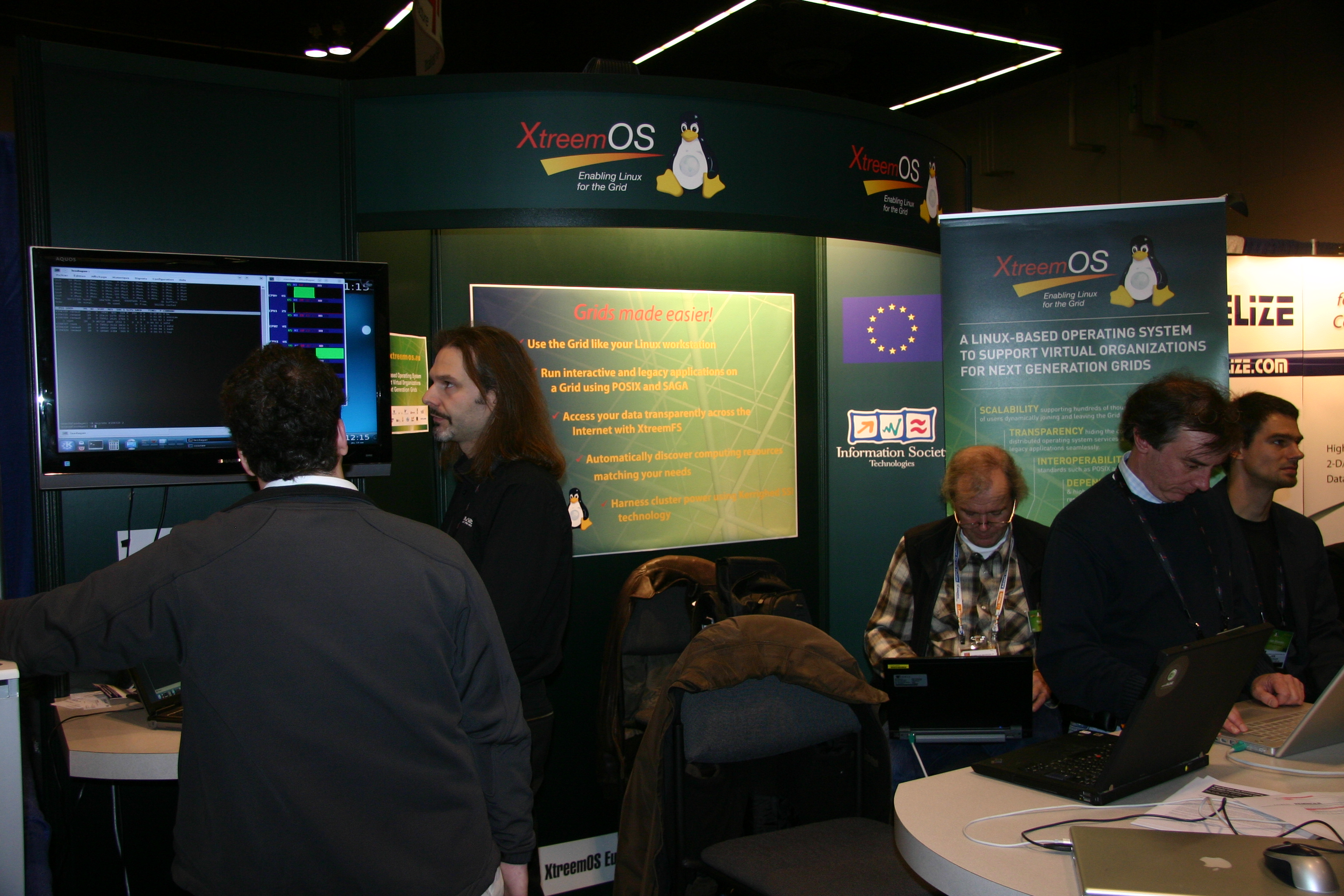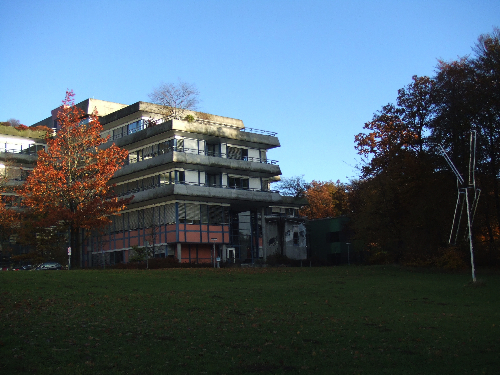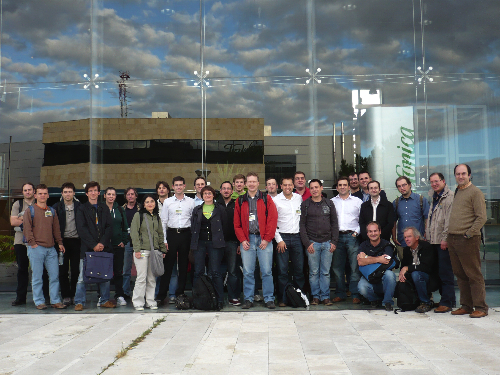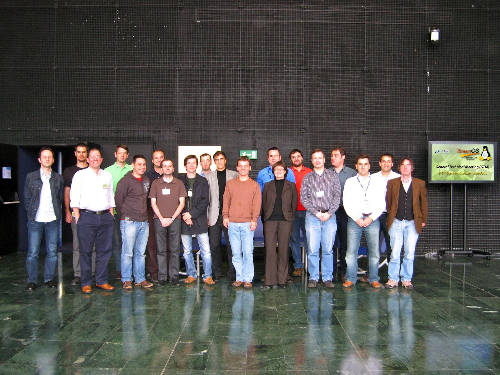Blog XtreemOS
2010-02-12
XtreemFS update 1.2.1
Source code and packages are available for download on http://www.xtreemfs.org.
There is no change in the database or OSD storage, so an update from 1.2 should work out of the box. The usual advice: backup important data before upgrading.
2010-02-11
Eurosys Doctoral Workshop - Deadline: February 14
The submission deadline for the Eurosys Doctoral Workshop is the 14th of February 2010. The workshop is co-located with Eurosys in Paris.
The web page is at http://research.microsoft.com/~risaacs/eurosys10dw.html
Here is a brief description from the organizers:
"The doctoral workshop, which will take place on the day before the main EuroSys 2010 program, will provide a forum for PhD students to present their work and receive constructive feedback from experts in the field as well as from peers. Technical presentations will be augmented with general advice and discussions about getting a PhD, doing research, and post-doctoral careers. We invite applications from PhD students at any stage of their doctoral studies, and plan to have about 30 attendees."
2010-02-04
XtreemOS 2.1 out very soon!
- Improved installer with a new xosautoconfig tool to greatly simply and automate installation of XtreemOS instances.
- A number of high impact bug fixes, along with work on stability and correctness.
- XtreemFS 1.2, which has a number of new features along with enhanced performance and stability
- XtreemOS MD (Mobile Device) - This new version integrates XtreemOS on Internet Tablets, beginning with the Nokia N810. This makes it possible to launch jobs and interact with XtreemOS resources via a special client.
- Virtual Nodes - a framework to provide fault tolerance for grid applications by replicating them over multiple nodes.
- XOSSAGA - a set of technologies to allow you to run SAGA compliant applications on top of XtreemOS unmodified.
2010-01-29
XtreemOS tutorial at OGF28
"Easing Application Execution in Grids with XtreemOS Operating System"
This tutorial presents XtreemOS Grid system from the user point of view. Its goal is to show why XtreemOS is a system of choice for Grid users who want to easily execute their applications while taking advantage of advanced features for job management. We show what can be done with XtreemOS with regards to application execution, how it can be done and how the available features are implemented. Demonstrations will be presented throughout the tutorial.
Target audience: Grid users, Grid application developers, Grid system and middleware designers
Session leaders: Christine Morin (INRIA), Yvon Jégou (INRIA), Toni Cortes (BSC), Michael Schöttner (Heinrich-Heine Universität Düsseldorf)
Session agenda
- Overview of XtreemOS
- Dynamic resource discovery for job execution
- Resource management
- Resource selection
- Resource reservation
- Resource (co-)allocation
- Job Management
- Job control
- Job dependency management
- Job monitoring & auditing
- Support for interactive applications
- Examples of job execution
- Workflow
- MPI applications
- Reliable job execution
- XtreemOS-GCP checkpointing service for distributed applications
- Integration of different checkpointer packages
- Generic callbacks for application-level optimizations
- Channel checkpointing with heterogenous checkpointer packages
- Executing SAGA applications on XtreemOS
Event date and location
OGF28
Ludwig-Maximilians-Universität München
Munich, Germany
March 15-19, 2010
More information: http://www.ggf.org/OGF28/
2010-01-13
XtreemOS 2.0 红旗Asianux版 发布
XtreemOS 2.0 RedFlag Asianux Version
XtreemOS 2.0 RedFlag Asianux Version available for download!
The XtreemOS 2.0 RedFlag Asianux Version is based on RedFlag Asianux 3.0SP2. You can find XtreemOS 2.0 official release notes at the following URL to learn about its functionalities:
../xtreemos-2-0-is-now-available.html
An installation tool is provided for users to install all XtreemOScomponents on RedFlag Asianux 3.0 SP2 with Tools-CD installed already. There is also a Chinese user guide in the "DOC" directory.
If you want to install the XtreemOS 2.0 RedFlag Asianux Version, please refer to the release notes in the disc.
Getting XtreemOS 2.0 RedFlag Asianux Version
The XtreemOS 2.0 RedFlag Asianux Version can be downloaded from the Red Flag website: http://dtoem.redflag-linux.com/hhp/

The source code is available at
https://gforge.inria.fr/plugins/scmsvn/viewcvs.php/distribution/packages/asianux/?root=xtreemos
Press release in Chinese
...on Red Flag's website:
http://www.redflag-linux.com/XtreemOS-2-0-Redflag-Asianux.html
2009-12-21
XtreemOS tutorial at EuroSys 2010
In April 2010 XtreemOS will have a half-day tutorial at the EuroSys conference.
We'll present and demonstrate the main features of XtreemOS, reflecting the progress that has been made with the last release.
We are welcoming users and developers of distributed applications, and also Grid system administrators, to participate to this tutorial. The attendees will learn how to use XtreemOS for executing and developing complex applications, for storing distributed data and for managing virtual organizations in a simple way. We hope everybody will enjoy discovering XtreemOS!
The tutorial will be presented by: Corina Stratan (VUA), Massimo Coppola (CNR) and Guillaume Pierre (VUA).
More details on the conference web site:
http://eurosys2010-dev.sigops-france.fr/program.html
2009-12-16
XtreemOS videos on YouTube
XtreemOS core demo (VO administration and job submission):
XtreemFS replication with failover - live demo:
- XtreemOS use case Wissemheim:
http://www.youtube.com/watch?v=OXR0Lm3UVjU
XtreemFS read-only replication:
http://www.youtube.com/watch?v=0co_-_e0Hq4
2009-12-14
Luscious Lebkuchen: XtreemFS 1.2 now available
XtreemFS 1.2 ("Luscious Lebkuchen") is now available at http://www.xtreemfs.org.
- asynchronous MRC database backups (database dumps are created in the background)
- new GRID SSL mode: SSL is used for authentication only, data is transferred via plain TCP for a better performance
- Vivaldi-based replica selection and placement
- MRC and OSD wait and retry for a configurable time span if they cannot reach the DIR on startup
- faster file copying of files with 'cp' (by providing correct values for 'st_blksize' with 'getattr')
- additional binaries with standard Unix names (mount.xtreemfs, mkfs.xtreemfs, lsfs.xtreemfs, rmfs.xtreemfs)
- experimental Hadoop file system driver for XtreemFS
- web-based admin console
2009-12-09
XtreemOS is on Facebook! ;-)
XtreemOS has its own facebook page!
It's worth mentioning that this Facebook page was created by someone external to the project - what a good idea...and thank you! ;-)

Wanna join the XtreemOS group on Facebook?
http://www.facebook.com/group.php?gid=77236338476&v=info#/group.php?gid=77236338476
2009-12-07
XtreemOS at SuperComputing 2009
XtreemOS exhibited for the 3rd time this year at Supercomputing '09 in Portland, Oregon. Sharing the booth were consortium partners INRIA, CNR, VUA, ZIB and Kerlabs.
During the show, the new version 2.0 of XtreemOS was demoed (along with the latest version of Kerrighed using their cluster in a box). Interest from visitors ranged from university faculty interested in integrating XtreemOS in their teaching to other research institutions wishing to join future development.

Despite the economic crisis, there were not many signs of retrenchment in investment or research in HPC (high performance computing). A number of ambitious future projects were unveiled at Supercomputing, along with record numbers of visitors.
One other highlight from the show was the keynote from former U.S. Vice President AL Gore, who addressed the topic of how supercomputing can be used to harness solutions to global climate change science.
Already, space for SC '10 is nearly sold out, which portends another record breaking exhibition.
2009-12-02
XtreemOS in the news
XtreemOS 2.0 release announcement
- International Science Grid This Week (English): "Announcement - XtreemOS 2.0 Release" - http://www.isgtw.org/?pid=1002216
- Linux Today (English): "XtreemOS 2.0 release: a Linux-based Grid Operating System" - http://www.linuxtoday.com/developer/2009111602335PRHESW
- Linux-Magazine (English): "XtreemOS 2.0 Manages and Mounts in Grid" - http://www.linux-magazine.com/Online/News/XtreemOS-2.0-Manages-and-Mounts-in-Grid/%28kategorie%29/0
- Emergences (newsletter from INRIA Rennes): "XtreemOS publie sa 2.0" - http://emergences.inria.fr/2009emergences/newsletter-n07/L07-XTREEMOS
- Toolinux (French): "XtreemOS 2.0 est arrivé" - http://www.toolinux.com/lininfo/toolinux-information/logiciels/article/xtreemos-2-est-arrive
- linuxfr.org (French): "XtreemOS 2.0 : grille de calcul multi plate-forme sous Linux" - http://linuxfr.org/2009/12/01/26224.html
- Silicon (French): "Un Sytème d'exploitation dédié aux clusters" - http://www.silicon.fr/fr/news/2009/11/24/xtreemos___un_systeme_d_exploitation_linux_dedie_aux_clusters
2009-11-17
Get acquainted with one XtreemOS partner: Ulm University (UULM)
Ulm University is located in the southern part of Germany. It was founded in 1967 and is therefore a rather young university. Nowadays there are about 7 000 students with main subjects in medicine, natural sciences, mathematics, economics, engineering and computer sciences. The computer science department has about 20 professors doing research and teaching in all major areas of computer science. Ulm University is partner of XtreemOS with the Aspectix Research Team as part of the Institute for Distributed Systems. The team and its 7 researchers are working on multimedia platforms, middleware systems for adaptive applications and fault tolerance.

UULM contribution to XtreemOS
Virtual Nodes
The main task of UULM in XtreemOS is the development of a fault tolerance infrastructure called Virtual Nodes that can be used for grid applications but also for XtreemOS-internal services. Virtual Nodes are a framework providing multiple configurable implementations for replication support, e.g., Virtual Nodes provide active and passive replication protocols. The most innovative element of Virtual Nodes is the support of concurrency for replicated services due to different deterministic scheduling algorithms. For adding new replicas a special join protocol was developed that supports consistent state checkpoints even with concurrent service activities. Current work is the integration of Virtual Nodes technology into the XtreemOS job management services. The integration into security services is under consideration.
Distributed Servers
In cooperation with Vrije Universiteit Amsterdam (VUA), UULM has contributed to the Distributed Server system that allows clients to use a fixed server address. The corresponding server socket can be moved between different server instances. UULM is working on the integration of Distributed Server technology with Virtual Nodes, which allows clients to remain completely agnostic about replication.
XtreemOS 2.0 release now available!
XtreemOS 2.0 Release
Rennes, France Nov 12, 2009 – The XtreemOS project has released the second public release of its Linux-based Grid operating system under the motto "Making Grid Computing Easier". The consortium has conceived and integrated a platform of open source technologies to enable easier usage, management, scalability and programming on top of Grid computing resources.
XtreemOS brings new capabilities to Grids, such as easing job submission and monitoring, while providing a comprehensive security implementation and virtual organization management. XtreemOS comes in three flavours: The PC flavour makes it possible to aggregate standalone PCs as computation resources into XtreemOS Grids. The XtreemOS cluster flavour is based on Kerrighed's LinuxSSI (single system image) technology. LinuxSSI is a Linux cluster providing users an image of a single large system. The third flavour, XtreemOS Mobile has been tailored to run XtreemOS services on mobile devices, such as Nokia Internet Tablets.
The 2.0 release version includes the following functionalities:
Creation and management of dynamic virtual organizations The security infrastructure includes a set of services that guarantee the secure operation of the system, providing management of credentials, permissions and resources.
Application execution management AEM is able to search available nodes that fulfill the application needs from within a large number of candidates and then execute the application on the selected nodes. AEM provides job and resource monitoring so that users can get a Linux-like view of their applications. A new experimental feature in this release is the ability to run interactive jobs such as graphical applications unmodified; harnessing the power of a Grid system. In addition, there is a new graphical tool for editing and managing job submissions. Lasty, grid checkpointing and job migration has been integrated into this version.
XtreemFS is a replicated and distributed object-based file system. It allows scaling an installation by adding machines with free storage resources. It offers striping of files over multiple storage servers for high performance parallel access. Furthermore, it supports automated mounting of home volumes.
XOSAGA programming interface The XOSAGA API is built using the Simple API for Grid Applications (SAGA) standard from the Open Grid Forum (OGF). It provides access to XtreemOS resources and services.
Xosautoconfig is a new tool included in the distribution, which assists Grid administrators and other users to quickly deploy XtreemOS nodes on Virtual Machines, Grids and test beds.
With this release, the XtreemOS consortium invites the participation of external contributors and feedback. XtreemOS is open source and GPL/BSD licensed. For more info please email: contact@xtreemos.eu There is a lively developer channel on #xtreemos-dev on irc.freenode.net, as well.
Getting XtreemOS
The second public version based on Mandriva Linux isos can be downloaded from the project website: software. The source code is available at http://gforge.inria.fr/plugins/scmsvn/viewcvs.php/?root=xtreemos Also available in the distribution are sample applications and demos.
About XtreemOS
Partially funded by the sixth framework programme (Contract FP6-033576) of the European Commission, XtreemOS is a 4-year research project, comprised of 19 academic and enterprise partners in Europe and China that aims to develop a Linux based grid operating system to simplify the usage, management and programming of grids.
Website: www.xtreemos.eu
2009-11-12
Slides of summer school available online!
The first XtreemOS summer school took place in Oxford, UK, last September 7-11, 2009.
The presentation slides are now available here (in technical programme).
2009-11-04
Get acquainted with one XtreemOS partner: Barcelona Supercomputing Center (BSC)
Early in 2004 the Ministry of Education and Science (Spanish Government), Generalitat de Catalunya (local Catalan Government) and Technical University of Catalonia (UPC) took the initiative of creating a National Supercomputing Center in Barcelona. BSC-CNS (Barcelona Supercomputing Center – Centro Nacional de Supercomputación) is the National Supercomputing Facility in Spain and was officially constituted in April 2005. BSC-CNS manages MareNostrum, one of the most powerful supercomputers in Europe, located at the Torre Girona chapel. The mission of BSC-CNS is to investigate, develop and manage information technology in order to facilitate scientific progress. With this aim, special dedication has been taken to areas such as Computational Sciences, Life Sciences and Earth Sciences.
All these activities are complementary to each other and very tightly related. In this way, a multidisciplinary loop is set up: our exposure to industrial and non-computer science academic practices improves our understanding of the needs and helps us focusing our basic research towards improving those practices. The result is very positive both for our research work as well as for improving the way we service our society.

BSC contribution to XtreemOS
- Application execution management
The main task of BSC in XtreemOS is to lead the research and development of the Application Execution Management (AEM) module. This module is in charge of setting the whole environment to run jobs in the grid (build reservations, allocate resources, schedule jobs, launch processes, etc.) and to control and monitor them (maintaining the state, allow thread-level monitoring, etc.).
Specifically BSC is highly involved in the scalable job management avoiding any kind of bottleneck as well as on the monitoring that allows users to monitor a job just as if it were a Linux process (you can even monitor the change of thread states).
- XtreemFS
 In the data management module, the storage system research group is in charge of the algorithm to locate the best replica of a file as well as to decide when and where replicas should be created and/or removed. This mechanism is base on an improved version of the Vivaldi algorithm that places all XtreemOS nodes into a 2D space based on communication latencies.
In the data management module, the storage system research group is in charge of the algorithm to locate the best replica of a file as well as to decide when and where replicas should be created and/or removed. This mechanism is base on an improved version of the Vivaldi algorithm that places all XtreemOS nodes into a 2D space based on communication latencies.
Mobile-device flavor
Regarding mobile devices, BSC is cooperating with TiD to build the embedded version of XtreemOS to be run on mobile devices. Mainly, BSC is working on the AEM and XtreemFS modules of XtreemOS-G for these devices.
Applications
 Finally, BSC is porting two applications trying to take full advantage of the benefits of this new system. These applications are specweb 2005 and hmmpfam which runs on top of COMPSs a workflow manager that is also ported to its full efficiency to XtreemOS by BSC.
Finally, BSC is porting two applications trying to take full advantage of the benefits of this new system. These applications are specweb 2005 and hmmpfam which runs on top of COMPSs a workflow manager that is also ported to its full efficiency to XtreemOS by BSC.
2009-10-27
XtreemOS 2.0 coming soon!
After several months of hard work and testing the XtreemOS consortium is pleased to announce a release candidate of XtreemOS 2.0.
Among the many improvements:
New graphical tools to install and manage XtreemOS.
Interactive Job Sessions - Run unmodified graphical applications on a grid.
Enhanced job management with the ability to make resource reservations.
A final 2.0 release is expected soon in ISO and virtual machine formats.
XtreemOS 2.0 will inlcude new, advanced features and more differentiating factors than XtreemOS 1.0. It will also be significantly easier to install and configure.
Download for XtreemOS-RC5 and RC6 here: ftp://distrib-coffee.ipsl.jussieu.fr/pub/linux/MandrivaLinux/devel/iso/xtreemos/2.0/
The RC5 version for 64 bits and RC6 for 32 bit are identical in content.
2009-10-13
XtreemOS at Poslovna Linux Konferenca
Poslovna Linux konferenca (Business Linux Conference) is an annual event in Slovenia, focussing on the use of Linux and other open-source software in business environments. This year the conference took place in Portorož on the 28th and 29th of September.
XtreemOS was presented by Marjan Šterk and Matej Artač (both from XLAB) as a platform for collaboration both within companies and across company borders. A potential use case in an architectural bureau was used to enumerate the most important features of XtreemOS in businesses: sharing files with XtreemFS, exploiting grid resources for automatic compilation of project documentation, marketing material, animations etc, and use of applications installed on remote computers without the need for local user accounts. A simplified live demonstration of these features was also shown.
XtreemOS general meeting in Valladolid
From 6th to 9th October, a General Technical Meeting was organized at Telefonica I+D premises in Valladolid, Spain.
With a large participation of around 40 people, the meeting was very productive, including many sessions devoted to security aspect, as well as XtreemOS file system, changes in AEM, etc. Plenary sessions for developers (specially focused on release 2.0 and also the future 2.1 release before Christmas), for demos and also for performance evaluation were also important in the agenda.

But not everything was just work, and the partners have enjoyed some activities "out-of-agenda", like a guided tour in Valladolid and the social event in Bodegas Arzuaga, one of the best wineries in the region (Ribera del Duero), where we visited the cellar and also enjoyed a dinner with the typical "lechazo" (young lamb) from Castilla. With a special mention also for "tapas": some XtreemOS members became experts and practiced this "regional sport" in even 5 different bars in just one night!

It is interesting to mention as well the visit from the chairman of Telefonica I+D premises in Valladolid, taking the opportunity to take some photos and to write a press release that will be published internally in Telefonica and also in regional newspapers.
2009-09-29
Feedback: XtreemOS summit at Euro-Par 2009
Delft, The Netherlands - August 25, 2009
The first XtreemOS summit was co-located with Euro-Par 2009 in Delft, The Netherlands.

The objective of this half-day summit was to present the XtreemOS technology with different talks ranging from a general overview to selected topics including security, resource matching, and parallel I/O. After the talks different demonstrations were run to show the benefits of the XtreemOS system.
The summit concluded with an interesting and fruitful discussion between the audience and the XtreemOS representatives.
XtreemOS summit webpage: here
Thilo Kielmann (VUA) also gave an invited talk at CoreGRID 2009 workshop (in conjunction with EuroPar): "XtreemOS a sound foundation for IaaS and cloud federations"
In addition, John Mehnert-Spahn (UDUS) presented an XtreemOS paper:
- "The Architecture of the XtreemOS Grid Checkpointing Service" by
2009-09-28
XtreemFS in the news
- heise (english) http://www.h-online.com/open/Distributed-file-system-for-the-internet--/news/114009
- heise (german) http://www.heise.de/open/Verteiltes-Dateisystem-fuers-Internet--/news/meldung/143550
- golem (german) http://www.golem.de/0908/69078.html
- Linux Magazin (german) http://www.linux-magazin.de/NEWS/XtreemFS-1.0-ist-fertig
- 01net.com (french) http://pro.01net.com/editorial/505038/avec-xtreemfs-leurope-a-son-systeme-de-fichiers-en-ligne/
More about XtreemFS: here







